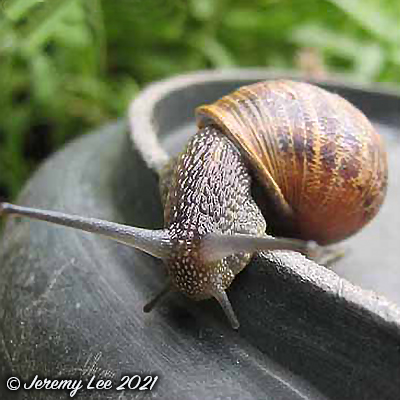
 |
|
Scientific Classifications explained » Amphibians » Ants » Aphids » Bees » Beetles » Birds » Bugs » Butterflies » Caterpillars » Damselflies » Dragonflies » Earwigs » Flies » Frog/Leafhoppers » Fungi » Galls » Grasshoppers » Harvestmen » Hoverflies » Lacewings » Ladybirds » Leaf Mines » Lichens » Mammals » Millipedes » Mosses » Moths » Sawflies » Slugs » Snails » Spiders » Trees & Shrubs » Wasps » Wild Flowers » Woodlice » Postboxes |
UK Nature > Snails > Helix aspersa

Scientific Name: Helix aspersa Common Name: Common Garden Snail Helix aspersa, or the Common Garden Snail, has grey, moist skin covered in little lumps. At the front end are four tentacles, the shorter two for feeling and the longer pair are eye stalks. The shell is usually light brown with darker brown bands following the spiral of the shell, although the shell colouration varies in its intensity from pale yellow to almost black. They are herbivores and feed on decaying vegetation, algae, fungi, lichens and plant leaves. As a part of their herbivorous diet they often feed on garden plants and are considered by some to be pests. Common snails have a symbiotic bacteria in their crop that enables them to digest cellulose - they have been known to feed on damp paper and cardboard. Because of their moist skin, common snails are most active in damp weather and at night. When conditions become too dry, the snail will retreat into its shell and seal the entrance with a parchment-like barrier known as an epiphragm. |
|

https://www.uknature.co.uk is a website dedicated to showing the immense diversity of UK nature and wildlife. Our vast range of habitats, from lowland arable to snow covered mountains, from storm-ravaged coastlines to peaceful inland freshwater lakes and rivers, from dry, sandy heaths to deciduous and coniferous forests, all these habitats contribute to the abundance of UK nature. We have wild birds in huge numbers either residing or visiting our shores (597 recorded species as at July 2013) and we must also not forget the humble back garden with its grass lawns, flower beds filled with nectar rich flowers, shrubs and trees, all designed to attract huge numbers of insects such as bees, moths, butterflies and hoverflies; and finally the small ponds which provide safe havens for frogs, toads, newts and even slow worms and grass snakes. www.uknature.co.uk is the showcase for my personal passion, photographing uknature in all its glory. I sincerely hope you all enjoy the fruits of my labours. This site and all images contained therein is © Jeremy Lee 2004 - 2025. All Rights Reserved. Site design by Jeremy Lee. Site development & IT Support by Stuart Lee. |